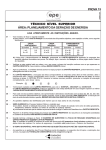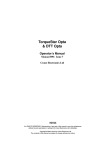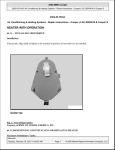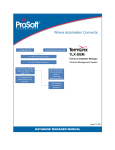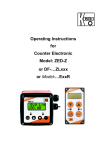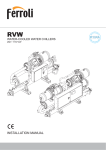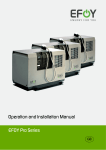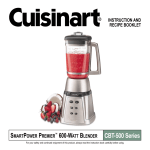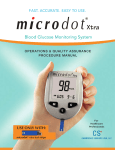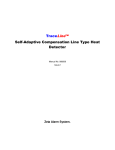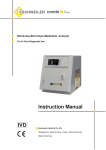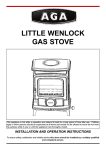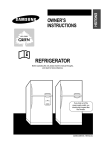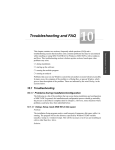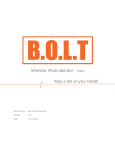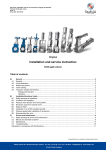Download MSDS - Traconed
Transcript
Data Sheet Medical Liquid Oxygen (O2) (Liquid cylinder supply) PRESENTATION Pharmaceutical form Compressed medical gas (for medicinal use only) Specification Complies with European Pharmacopoeia specifications 1985 Purity (gas phase) Carbon dioxide Carbon monoxide 99.5% (min) 300.0vpm (max) 5.0vpm (max) Physical data Molecular weight 32.00 Physical state in cylinder Liquid Specific volume at 15°C and 1013mb 738.2 l/kg Boiling Point at 1013mb –183°C Density of gas at 15°C and 1013mb 1.355 kg/m3 Density of liquid (at boiling point) 1.14 g/ml Critical temperature –118.4°C Specific gravity of gas at 15°C and 1013mb 1.106 Gaseous oxygen is colourless, odourless, tasteless, non-toxic, non-irritant and non-flammable but supports combustion vigorously. Liquid oxygen is pale blue, boiling at –183°C at atmospheric pressure. In the gaseous state of 15°C and 1013mbar its volume increases approximately 840 times. USES Modern anaesthetic practice is almost totally dependent on oxygen which provides a dimension of safety that makes possible some of the complicated medical manoeuvres required by modern surgery, and without which the risks would be too great to justify the method. Of equal value is the use of oxygen in intensive care units where it provides the main life-saving support, particularly for patients whose lungs need to be artificially ventilated if they are to survive. Although the immediate management of cardiac arrest does not depend on an oxygen supply other than that in the ambient air, continued treatment almost invariably depends on artificial ventilation with supplementary oxygen. The use of oxygen in chronic respiratory and cardiac conditions is very often essential and it is needed for the relief of all forms of hypoxia other than histotoxic. In short, modern medicine could not be practised without the support that oxygen provides. Oxygen is widely used: ■ in clinical practice to provide a basis for virtually all modern anaesthetic techniques as well as pre and post-operative management. 1 ■ to restore the tissue oxygen tension towards normal by improving oxygen availability in a wide range of conditions, such as: – cyanosis of recent origin as a result of cardio-pulmonary disease – surgical trauma, chest wounds and rib fractures – shock, severe haemorrhage and coronary occlusion – carbon monoxide poisoning – hyperpyrexia – major trauma, eg. road traffic accidents and gunshot wounds ■ in the management of sudden cardiac and respiratory arrest, whether drug induced or traumatic. ■ in the resuscitation of the critically ill when the circulation is impaired. ■ in neo-natal resuscitation. DOSAGE AND ADMINISTRATION There is no distinction generally between the use of oxygen in age groups other than neonates (see below). The fundamental indication is the presence of hypoxia due to whatever cause. Modern oxygen usage requires separate devices for administering the gas in high and in low concentrations. The lowest concentration should not fall below that present in ambient air (20.9%). These devices have been classified as follows: Fixed Performance Systems (patient-independent) ■ high flow – venti masks. ■ low flow – anaesthetic circuits. In all these systems the oxygen concentration is pre-determined by the clinician. Variable Performance Systems (patient dependent) ■ without re-breathing – catheters and cannulae. ■ with re-breathing through a face mask such as the MC Edinburgh and Pneumask. These systems only function by means of the patient who creates the inspired mixture by the act of breathing. Various patient and device factors influence the result. Special care is needed when oxygen is administered: ■ to neonates where the inspired concentration should not exceed 40% because of the risk of retrolental fibroplasia. ■ to elderly chronic bronchitic patients in whom the inspired concentration should only be raised in stages of 1% and probably should not exceed 30%. ■ in hyperbaric chambers in the management of conditions such as carbon monoxide poisoning, anaerobic infections and acute ischaemic disease. Convulsions and other central nervous system (CNS) effects may occur at 2 atmospheres or more, after a few hours exposure to pure oxygen. At higher pressures more rapid onset of CNS symptions will occur. Careful monitoring is required, but modern methods of measuring oxygen in breath, blood and tissues have made this relatively simple. Almost invariably, oxygen is administered through the lungs by inhalation. The major exception is when a metered supply is fed into the oxygenator of the extracorporeal circulation of a cardio-pulmonary by-pass system. 2 CONTRA-INDICATIONS, WARNINGS ETC There are no absolute contra-indications to the use of oxygen but the inspired concentration should be limited in the case of premature infants and those patients with chronic bronchitis and emphysema. Interactions with other medicaments and other forms of interaction The pharmacokinetic activity of oxygen is modified by changes in the blood carbon dioxide tension but this has little clinical significance. Effects on ability to drive and to use machines In normal circumstances, oxygen does not interfere with the conscious level but patients who require continuous oxygen support will require individual assessment as to their ability to drive or to operate machinery. Other undesirable effects (frequency and seriousness) Oxygen toxicity can occur as manifested by: ■ retrolental fibroplasia in premature infants exposed to oxygen concentrations greater than 40%. ■ central nervous system toxicity including dizziness, convulsions and loss of consciousness after only 2-3 hours of exposure to pure oxygen at 2 or more atmospheres, e.g. sports and deep sea diving. ■ retrosternal soreness associated with coughing and breathing difficulties, made worse by smoking and exposure to cold air after breathing pure oxygen at atmospheric pressure for several hours. Use in pregnancy and lactation Oxygen does not adversely affect pregnancy and lactation. Other special warnings and precautions Oxygen supports combustion and smoking should be prohibited when oxygen is in use and no naked flame should be allowed. Care is needed in the handling and use of medical oxygen gas cylinders. Overdose (symptoms, emergency procedures, antidotes) As detailed in ‘Other undesirable effects’. Incompatibilities (major) There are no incompatibilities with oxygen in clinical practice. PHARMACEUTICAL PRECAUTIONS Cylinders should be kept out of the reach of children. Oxygen is non-flammable but strongly supports combustion (including some materials which do not normally burn in air). It is highly dangerous when in contact with oils, greases, tarry substances and many plastics due to the risk of spontaneous combustion with high pressure gases. The normal precautions required in the storage and use of medical gas cylinders are applicable. These are fully explained in the associated brochure ‘Gas Safe – in the hospital’ and on the reverse of this Data Sheet. United Nations Substance Identification (UNSI) No. 1073 Emergency action code (Hazchem) 2PE A.D.R Hazard identification No. 225 C.E.F.I.C. tremcard No. 119 3 Occupational exposure standard (OES) There is no OES for medical liquid oxygen in the UK. Health hazard information Hazards to health arise from intense cold or displacement of air by rapidly evaporating liquid. Effect of cold on lungs Transient exposure to very cold gas can provoke an attack of asthma in susceptible subjects. Prolonged breathing of extremely cold gas may damage lung tissue. Cold burns and frostbite Because of the low temperature of liquefied gases, below –183°C, the liquid or even cold vapour or gas can produce damage to the skin. Unprotected parts of the skin coming in contact with uninsulated items of cold equipment may also stick fast to them and the flesh may be torn on removal. Symptoms Local pain usually gives warning of freezing, but sometimes no pain is felt or is short lived. Frozen tissues are painless and appear waxy, with a pale yellowish colour. Thawing of the frozen tissue can cause intense pain. Shock may occur if the area is large. Immediate treatment Loosen any clothing that may restrict blood circulation and seek immediate hospital attention for all but the most superficial injuries. Do not apply direct heat to the affected parts, but if possible place the affected part in lukewarm water. Sterile dry dressings should be used to protect damaged tissues from infection or further injury, but they should not be allowed to restrict the blood circulation. Alcohol and cigarettes should not be given. Hypothermia A risk of hypothermia arises when liquefied gases are released. All persons at risk should be warmly clad. Hypothermia is possible in any environment below 10°C, but susceptibility depends on length of exposure, atmospheric temperature and, not least, the individual; older people are more likely to be affected. Symptoms The symptoms of hypothermia are: (i) A slowing down of physical and mental responses (ii) Unreasonable behaviour or irritability (iii) Speech or vision difficulty (iv) Stumbling Treatment If possible take the person’s temperature. The mouth temperature should be over 96°F (35°C). Persons apparently suffering from hypothermia should be wrapped in blankets and moved to a warm place. Seek immediate medical attention. No direct form of heating should be applied except under medical supervision. Protective clothing Liquid oxygen is extremely cold. To prevent injury from unprotected parts of skin coming in contact with cold parts of the equipment, it is recommended that nonabsorbent leather gloves and goggles or protective glasses are worn during filling 4 operations. If clothing becomes contaminated with liquefied gas or vapour, the wearer should ventilate it for a minimum of 5 minutes, walking around in a well ventilated area. High reactivity The following points apply to oxygen and oxygen-enriched air: 1 Oxygen is an active element which, although non-flammable, supports combustion of almost all materials. As a result, materials which are normally only combustible at elevated temperatures in air will burn violently in oxygen with the smallest source of ignition (see section on materials). 2 Oil and grease should never be used on equipment for oxygen service. Pipes, fittings and controls in contact with oxygen must be degreased. 3 No fuel, paint, solvent or other volatile flammable material may be stored within 3m (10ft) of a liquid oxygen cylinder. 4 Oxygen must never be used as a substitute for compressed air or nitrogen. 5 Impregnation of clothing by oxygen must be prevented as a minute spark will ignite oxygen-impregnated cloth causing serious burns. 6 With good ventilation at ambient temperatures, oxygen will disperse quickly. However, cold gas (for example from a liquid leak), or leakage into badly ventilated chambers, will seep into porous materials, soil fissures, drains and ducts. Ignition sources should then be avoided. Before entering or working in such spaces, the atmosphere should be checked by suitable gas detection equipment. Fire It is not usually possible to extinguish an oxygen-fed fire using conventional means. The first essential step in extinguishing such a fire is to eliminate the source of supply of the oxygen. Conventional methods may then be employed as necessary. Usually a white mist forms by the condensation of atmospheric moisture when liquid oxygen is in contact with it and this indicates the approximate extent of the area of oxygen enrichment. Although fire may not be involved, the chance of accidental ignition is reduced by the use of water fog which also helps to dissipate the oxygen. Materials Where low temperatures are encountered due to contact with cold gas or liquid, some metals and plastics become extremely brittle and may fracture. Stainless steels, nickel steels and copper have good low temperature characteristics. BOC will advise on appropriate materials and safeguards against low temperature embrittlement on request. With liquid oxygen extreme care must be taken in the choice of jointing materials which must be compatible with oxygen. Expert advice should be sought. The surface finish can also be important where liquid oxygen or high pressure gaseous oxygen is concerned. Advice can be obtained on materials through BOC Safety Officers. Liquid oxygen transfer As any leakage of liquid oxygen onto combustible material (such as carpeting, wooden tiles, bitumen and asphalt) is potentially explosive, it is strongly recommended that all transfer operations are carried out on non-combustible, non-porous flooring such as concrete, cement or paving tiles. In the event of a leak, where it is safe to do so, the source of liquid should be isolated and the area ventilated. 5 LEGAL CATEGORY General sales list PACKAGE QUANTITIES Liquid cylinder data Model Nominal liquid capacity (litres)1 Nominal gas capacity (litres) Nominal operating pressure (bar) Continuous flow rate (l/min)2 Approx weight empty (kg)3 Approx weight full (kg)4 Approx cylinder dimensions (mm) LC 200 200 148000 5.2-12.1 150-300 116 316 1588 x 508 dia DLC5 30 30 25800 1.5 0.5-10 21 55 787 x 356 dia DLC5 1 1.2 1032 1.5 0.5-10 2.6 3.9 318 x 185 dia NOTES 1. Actual liquid volume may vary during storage. 2. Actual flow-rates may vary depending upon the number of liquid cylinders in use. 3. This is the approximate weight of the liquid cylinder and control equipment without gas. 4. This is the approximate weight of the empty liquid cylinder and control equipment together with the nominal capacity of liquid. 5. BOC Walkabout service only. FURTHER INFORMATION Expiry date Three years from filling date Pharmacological particulars The characteristics of oxygen are: ■ Odourless, colourless gas ■ Molecular weight: 32.00 ■ Boiling point: –183.1°C (at 1 bar) ■ Density: 1.355kg/m3 (at 15°C) Oxygen is present in the atmosphere at 21% and is an absolute necessity for life. The basal oxygen consumption in man is about 250ml/min for a body surface of 1.8sq metres. It is reduced by about 10% during anaesthesia and natural sleep and by about 50% for a 10°C fall in body temperature. Alveolar air contains about 14% oxygen at 14 kpa (105mm Hg) and the arterial blood has an oxygen tension of 13 kpa (97mm Hg). The difference known as the alveolararterial oxygen tension gradient, increases with age. The difference may be as great as 4 kpa (30mm Hg) in a healthy, elderly individual. Oxygen in the blood is mostly combined with haemoglobin. Normally haemoglobin in arterial blood is 97% saturated and the oxygen content of the blood in 19.8 vol %, 0.3ml of this being carried in solution. The remainder is held in chemical combination with haemoglobin. The concept of oxygen availability can be expressed as the product of the cardiac output and the oxygen content of the blood. The average healthy individual with a basal oxygen consumption has no more than 4 minutes supply of oxygen in the blood. 6 Pharmacokinetic particulars The uptake of oxygen by the blood in the lungs and discharge to the tissues is determined by the oxygen dissociation curve. The characteristic sigmoid shape ensures that, at tensions between 5kpa (40mm Hg) and 2kpa (15mm Hg), the oxygen carried in the blood from the lungs can be readily given up to the tissues. Oxyhaemoglobin Dissociation Curve The uptake from the lungs is rapid because blood flow through the capillaries, where exchange takes place, occurs in about 0.5 seconds. The uptake of oxygen is favoured by the simultaneous loss of carbon dioxide which is then excreted in the expired air. Conversely the entry of carbon dioxide into the blood from the tissues facilitates oxygen transfer to the cells. At rest, mixed venous blood returning to the lungs contains 13-14ml of oxygen per 100ml, but with severe exercise, the oxygen content may fall to 3-4ml. In very active tissue, almost complete extraction occurs. PRODUCT LICENCE NUMBER PL0735/0009 DATE OF PREPARATION June 1994 (Revision 1) Customer Service Centre Priestley Road Worsley Manchester M28 2UT Tel: 0800 111 333 Fax: 0800 111 555 www.boc.com [email protected] BOC Medical is a trading name used by operating companies within The BOC Group, the parent company of which is The BOC Group PLC. The stripe symbol and the word BOC are registered BOC Group trademarks. Copyright The BOC Group PLC 2002. 7 Safe handling and storage of medical liquid oxygen cylinders The following practices are recommended for the safe storage, handling and use of medical liquid oxygen cylinders. General 1. Only trained persons should handle liquid cylinders. 2. Observe all regulations and local requirements regarding the storage of liquid cylinders. 3. Do not remove or deface labels provided by BOC for the identification or the contents. 4. Ascertain the identity of the gas before using it. 5. Know and understand the properties and hazards associated with each gas before using it. 6. Before using liquid cylinders, establish plans to cover any emergency situations that might arise. 7. When doubt exists as to the correct handling procedure, contact BOC. 8. If you own your liquid cylinder you must be aware of, and discharge, your statutory obligations with regard to maintenance and testing. 9. Ensure that any driver that collects a liquid cylinder from a supplier has been properly instructed in the method of handling liquid cylinders and in dealing with any emergency. Storage 1. Liquid cylinder storage compounds should be purpose-built and well ventilated. 2. Liquid cylinders should be used and stored in locations free from fire risk and away from sources of heat and ignition. 3. The liquid cylinder storage compound should be kept clear and access restricted to authorised persons only. The compound should be clearly marked as a liquid cylinder store and appropriate hazard warning signs displayed (e.g. oxidant, liquid gas etc.) 4. Smoking and the use of naked flames either inside or in the vicinity of the liquid cylinder storage area should be prohibited. 5. Liquid cylinders should be stored in the vertical position and properly secured to prevent toppling. 6. Liquid cylinders stored in the open should be protected against extremes of weather. 7. Full and empty liquid cylinders should be stored separately and full liquid cylinders arranged so that the oldest stock is used first. 8. Liquid cylinders held in storage should be periodically checked for general condition and leakage. Handling and use 1. Only use appropriate trolleys, roller bases or overhead hoists correctly attached for transporting liquid cylinders even for a short distance. 2. Liquid cylinders should always be stored and operated in a vertical position. 3. Never lay, store or move a liquid cylinder on its side. 4. Check for gas leaks using approved leak detection solution. 5. Before connecting the liquid cylinder for use, ensure that back feed from the system into the cylinder is prevented. 6. Before connecting liquid cylinders check the complete gas system for suitability, particularly for pressure rating and materials. 7. Never permit liquefied gas to become trapped in parts of any system as this may result in rupture of the system. 8. Ascertain that all electrical systems in the area are suitable for service with each gas. 9. Never use direct heat or electrical heating devices to raise the pressure of a liquid cylinder. 10. Never re-compress a gas from a liquid cylinder without consulting the supplier. 11. Never attempt to transfer gases from one liquid cylinder to another, except where they are specifically designed for this operation. 12. Do not attempt to increase draw-off rate by adjusting the pressure setting without first checking with the supplier. 13. Do not use the liquid cylinder for any other purpose than to contain the gas as supplied. 14. Never permit oil, grease or other readily combustible substances to come into contact with valves. 15. Keep valve outlets clean and free from contaminants, particularly oil and water. 16. Do not subject liquid cylinders to abnormal mechanical shocks which may cause damage to their valves, safety devices or the vessel itself. 17. Never attempt to repair or modify valves or safety relief devices. ANY DAMAGE to valves should be reported to BOC. 18. Close the outlet valve and pressure building valve whenever gas is not required, even if the liquid cylinder is still connected to the equipment. 19. Liquid cylinders should be positioned in such a way that discharge from safety devices does not impinge on other cylinders or apparatus or into areas used by personnel. Further information concerning specific problems arising from the storage and handling of gases, hazards and first aid treatment can be obtained from BOC. General references Handbook of Compressed Gases, Compressed Gas Association Inc. Reinhold (1990). Patty, F.A. Editor Industrial Hygiene and Toxicology 3rd edition, Vol 2, John Wiley & Sons (1981). Gas Data Book, Matheson Gas Products (1971). British Compressed Gas Association, CP-9 Code of Practice. The Safe Filling, Handling, Storage and Distribution of Gases in Transportable Containers (1982). Safe Under Pressure – BOC Limited. Gas Encylopedia – L’Air Liquide, Elsevier (1976). Care with Cryogenics – BOC Limited. Liquid Cylinder User Manual – BOC Limited. 8 SAFETY DATA SHEET 1. Identification of the substance/preparation and of the company 097B MSDS Nr Oxygen (refrigerated) Product name 02 Chemical formula Company identification 0645-645555 Emergency telephone 0800 111 333 2. Composition/information on ingredients Substance/Preparation Components/Impurities CAS Nr EEC Nr (from EINESC) 3. Hazards identification Hazards identification 4. First aid measures Inhalation Skin/eye contact Ingestion 5. Fire fighting measures Specific hazards Hazardous combustion products Suitable extinguishing media Specific methods Special protective equipment for fire fighters 6. Accidental release measures Personal precautions Environmental precautions Clean up methods 7. Handling and storage Handling and storage 8. Exposure controls/personal protection Personal protection 9. Physical and chemical properties Molecular weight Melting point Boiling point Critical temperature Relative density, gas Relative density, liquid Vapour pressure 20°C Solubility mg/1 water Appearance/Colour Odour Autoignition temperature Flammability range Other data Substance. Contains no other components or impurities which will influence the classification of the product. 07782-44-7 2319569 Refrigerated liquefied gas. Contact with product may cause cold burns or frostbite. Oxidant. Strongly supports combustion. May react violently with combustible materials. Continuous inhalation of concentrations higher than 75% may cause nausea, dizziness, respiratory difficulty and convulsion. Immediately flush eyes thoroughly with water for at least 15 minutes. In case of frostbite spray with water for at least 15 minutes. Apply a sterile dressing. Obtain medical assistance. Ingestion is not considered a potential route of exposure. Supports combustion. Exposure to fire may cause containers to rupture/explode. Non flammable. None. All known extinguishants can be used. If possible, stop flow of product. Cool with water from a protected position. None. Evacuate area. Ensure adequate ventilation. Eliminate ignition sources. Use protective clothing. Try to stop release. Prevent from entering sewers, basements and workpits, or any place where its accumulation can be dangerous. Ventilate area. Keep area evacuated and free from ignition sources until any spilled liquid has evaporated. (Ground free from frost.) Use no oil or grease. Segregate from flammable gases and other flammable materials. Suck back of water into the container must be prevented. Do not allow backfeed into the container. Use only properly specified equipment which is suitable for this product, its supply pressure and temperature. Contact your gas supplier if in doubt. Keep ignition sources (including static discharges) away from vessel. Refer to supplier’s operating instructions. Do not smoke while handling product. Ensure adequate ventilation. Protect eyes, face and skin from liquid splashes. Avoid oxygen rich (>21%) atmospheres. 32 –219°C –183°C –118°C 1.1 (air=1) 1.1 (water=1) Not applicable. 39mg/1. Bluish liquid. No odour warning properties. Not applicable. Oxidiser. Gas/vapour heavier than air. May accumulate in confined spaces, particularly at or below ground level. 9 10. Stability and reactivity Stability and reactivity May react violently with combustible materials. May react violently with reducing agents. Violently oxidises organic material. Liquid spillages can cause embrittlement of structural materials. Risk of explosion if spilt on organic structional materials (eg wood or asphalt). 11. Toxicological information General See page 3. 12. Ecological information General Can cause frost damage to vegetation. 13. Disposal considerations General 14. Transport information UN Nr Class/Div Subsidiary risk ADR/RID Item Nr ADR/RID Hazard Nr Tremcard Nr Labelling ADR Other transport information 15. Regulatory information Number in Annex 1 of Dir 67/548 EC Classification – Symbols – R Phrases – S Phrases Labelling – Symbols – Risk phrases – Safety phrases To atmosphere in a well ventilated place. Do not discharge into any place where its accumulation could be dangerous. Contact supplier if guidance is required. 1073 2.2 5.1 2,7a 225 119 Label 05: fire intensifying risk. Label 2: non flammable non toxic gas. Avoid transport on vehicles where the load space is not separated from the driver’s compartment. Ensure vehicle driver is aware of the potential hazards of the load and knows what to do in the event of an accident or an emergency. Before transporting product containers ensure that they are firmly secured and: – adequate ventilation. – compliance with applicable regulations. 008-001-00-8. O;R81C;R34 O: Oxidising. 8-34. 21 Road transport symbols are used and selected according to the most stringent product classification – EC or ADR. Label 2: non flammable non toxic gas. Label 05: fire intensifying risk. R8A Strongly supports combustion. RFb May cause frostbite. S17A Keep away from combustible material, use no oil or grease. S9 Keep container in well ventilated place. S36A Use suitable protective equipment. 16. Other information Ensure all national/local regulations are observed. Ensure operators understand the hazard of oxygen enrichment. Before using this product in any new process or experiment, a thorough material compatibility and safety study should be carried out. Details given in this document are believed to be correct at the time of going to press. Whilst proper care has been taken in the preparation of this document, no liability for injury or damage resulting from its use can be accepted. MED/004043/APUK/1206/5C 10










